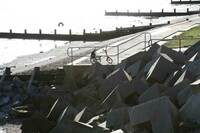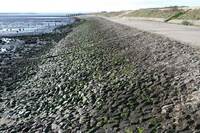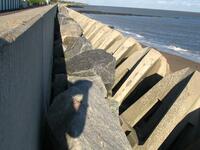- England
- Scotland
- France
- Holland
- Germany
- Italy
- Spain
- Portugal
- USA
- China
- Japan
- India
- Iran
- Advice
- Gardens
- England
- Scotland
- France
- Holland
- Germany
- Italy
- Spain
- Portugal
- USA
- China
- Japan
- India
- Iran
- Advice
- Garden Tours
Book: Landscape Planning and Environmental Impact Design: from EIA to EID
Chapter: Chapter 9 River engineering, channelization and floods
Coastal 'defence', like river 'improvement', has too often been regarded solely as an 'engineering problem'. The US Army Corps of Engineers gave a classic statement of this attitude in 1964: Our campaign against the sea must be waged with the same care that we would take against any other enemy threatening our boundaries (Clark 1982). Like British engineers they ignored natural processes and social factors. As a consequence of this approach many coastal areas suffered damage to their ecology and amenities. The exceptions are sandy coasts, where the protective value of dune vegetation has been recognised, and resort towns, where some effort has been made to adapt sea walls for amenity use. The oldest method of sea defence is the construction of earth embankments. It was used in Egypt and Mesopotamia and remains in widespread use. Sea embankments normally cause either erosion or deposition. When they are positioned to gain extra land, wave energy tends to be concentrated in a physically smaller zone and erosion is increased. Littoral vegetation is lost and the shoreline available for recreational use is diminished. If the erosion problem is severe, earth embankments are surfaced with stone, concrete and bitumen to give additional protection. Such works are rarely pleasing to the human eye, or to wildlife, though they can give convenient road access to beaches. Extensive works of this kind are found on the coast of Holland. Since more than half of Holland owes its existence to sea defence, it is understandable that priority should have been given to engineering considerations. It is possible to enhance the amenity value of an embanked coast by introducing more variation into the design of the bank profiles, by adjusting the alignment to create new wildlife habitats, and by recharging the foreshore with sand and gravel [Fig 9.25]. The nineteenth century development of seaside resorts introduced a new consideration into the design of sea walls. Visitors who came for sea air and good views did not wish to be cut off from the sea by embankments. Engineers responded by constructing vertical sea walls with promenades on top. It is now known that these walls had a deleterious effect on beach erosion. They deflect part of the wave energy downwards and cause the water to erode the foreshore. Many authorities responded by constructing groynes which look like military defences against a seabourne invasion. They have some effect in diminishing longshore drift but are more effective on gravel than sandy beaches. If groynes do succeed in trapping beach material they will cause increased erosion on adjacent downdrift beaches. As with river improvements, a 'solution' in one place causes problems in another ï¾ and a need for more engineering work. In Britain this problem has been aggravated by the fact that 'coastal protection' of urban areas comes under the Department of the Environment, and 'sea defence' of agricultural land comes under the Ministry of Agriculture Fisheries and Food (Trafford & Braybrooks 1982). In 1982, the Deputy Director of the Hydraulics Research Station endorsed an American account of coastal defence work: For more than a century in the USA jetties, groins, seawalls and other structures have been built in a futile effort to trap sand and to protect beaches. These structures, designed to alter the sediment flow and to interfere with the natural equilibrium of the beach, have in most cases caused further problems. Engineers and planners in the United States now believe that the best method for beach restoration should not alter the natural processes ï¾ rebuilding beaches artificially (beach nourishment) by replacing sand lost to the system permits the natural process to continue unhampered (Price 1982). Smallï¾scale beach recharge has been practised in Britain for many years. The first major project was the 'renourishment' of Bournmouth Beach as a pilot project in 1970. It was followed by a 1.6 kilometre scheme at Portobello, outside Edinburgh, in 1972, and a 8.5 kilometre scheme at Bournmouth in 1974ï¾5. These projects have been very successful both in protecting the old sea walls from further erosion and improving the recreational value of beaches. They are also cheaper than concrete walls (Thorn & Roberts 1981). The town of Sheerness, which has always been prone to flooding, exhibits four different approaches to the design of sea defences. The old sea wall was an earth embankment surfaced with stonepitching. When the town began to flourish as a holiday resort, a new amenity sea wall was built east of the old town. It is a fine Edwardian seaside structure with a stepped wall and semiï¾circular platforms surmounted by elegant pavilion shelters. During the 1970s a third type of sea wall was built in Sheerness [Fig 9.26]. It is a plain concrete bank surmounted by a walkway and a curved wall which is designed to reflect wave energy outwards. The wall was kept low, to preserve views from seafront houses, and the landward side was designed by an architect (Thorn & Roberts 1981). A fourth type of sea defence was also constructed during the 1970s and has a better environmental impact. It is a beach recharge scheme using gravel instead of sand. The gravel was dredged from the sea and pumped ashore from barges. Beach recharge is the most 'natural' method of sea defence but, as with other types of barrier, its environmental impact must be designed. The opportunity should be taken to establish new plant communities and to create recreational facilities. At Sheerness the beach is used by a catamaran club and by windsurfers. They are able to use an old ramp to gain access to the shore but the roadway is steep, narrow, and without a proper turning area at the top or bottom of the slope. If the access road had been properly designed, and vegetation established on the landward slope of the bank, the impact of the gravel bank on the environment would be better. The planning of sand dune coasts is relatively advanced. Ian McHarg carried out a coastal landscape planning project in New Jersey after a great storm in 1962. He observed the damage which was done because holidayhomes had been built amongst the dunes without regard to the planning principles which had been known to the Dutch for centuries: Fortyï¾foot waves pounded the shore, breached the dunes and filled the bay, which spilled across the islands back to the ocean. When the storm subsided, the extent of the disaster was clear. Three days of storm had produced eighty million dollars worth of damage, twentyï¾four hundred houses destroyed or damaged beyond repair, eightyï¾three hundred houses partially damaged, several people killed and many injured in New Jersey alone (McHarg 1971: 16). McHarg recommended the adoption of measures to preserve 'the dune grass, hero of Holland' and other vegetation. Plant roots bind the sand and create a flexible, permeable barrier with great capacity to absorb water and wave energy without giving way. Pedestrian access erodes dune vegetation. In by far his most convincing example of 'ecological planning', McHarg recommended unlimited recreational use of the beach, a prohibition on access to the primary dune, some recreational use of the trough behind the primary dune, and no building development on the secondary dune. He said that building development should be confined to the comparatively stable and 'more permissive' environment of the backdune.


